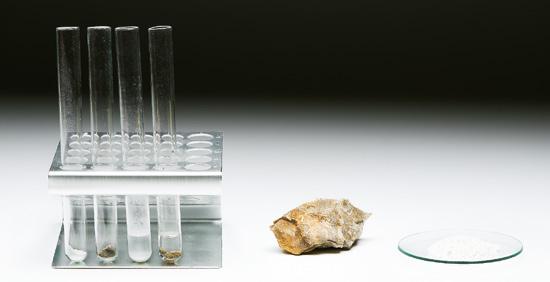
2 minute read
Factors that affect the reaction
PRACTICAL WORK
Factors that affect LA the reaction rate
PROCEDURE
Safety measures Both reactions release gases. Use safety glasses to avoid being splashed. Experiment 1: Degree of sub-division of a solid reactant • Place a known mass of limestone powder in one test tube and the same mass of marble pieces in another. Add enough water to both tubes to suspend the limestone powder and cover the marble pieces. • In two different test tubes, measure out the same amount of hydrochloric acid. • Carefully add the hydrochloric acid to the original test tubes with care. Write down what happens. PROPOSED PROBLEM Analyse the effect of the degree of sub-division in a solid reactant, the concentration, and the presence of catalysts on the reaction rate. To do so, we suggest you do the following experiments with these two chemical reactions: Reaction 1: CaCO3 (s) + 2 HCl (aq) 8 CaCl2 + CO2 (g) + H2O Reaction 2: Zn (s) +H2SO4 (aq) 8 ZnSO4 + H2 (g) YOUR PROPOSAL Design one experiment to check qualitatively how reactant concentration and degree of sub-division of a solid reactant affect the reaction rate. Design another to test the effect of a catalyst. OUR PROPOSAL Both reactions release a gas. So the speed of the gas bubbles could give an idea of the reaction rate. Only change one variable per experiment. YOU WILL NEED • Powdered limestone • Marble pieces • Hydrochloric acid solution • Copper and zinc pieces • Diluted sulfuric acid solution • Test tubes • Tube rack • Volumetric flask • Distilled water
Experiment 2: Reactant concentration • Prepare two more test tubes of hydrochloric acid diluted to half the original concentration. • Repeat experiment 1, with just the marble in distilled water. Repeat the experiment three times: once with the original hydrochloric acid concentration and twice with the diluted concentration.
Experiment 3: Presence of a catalyst • Put the pieces of zinc in a test tube and cover them with the diluted sulfuric acid solution. Observe and write down what happens. • In another test tube, combine the zinc and copper pieces and add the same amount of diluted sulfuric acid. Observe and write down what happens. Understand, think, search...

1 Prepare a table with the conditions of each experiment, together with your observations and draw conclusions. 2 From experiment 3, do another experiment with only the catalyst, the copper, and the acid. What do you see? 3 Would we get the same results as in experiment 3 if we used a compound of copper, such as copper sulfate, instead of copper? Could we say that the copper sulfate catalysed the reaction? Justify your answer.








